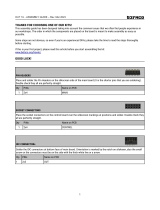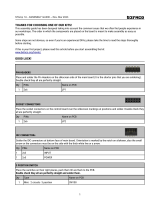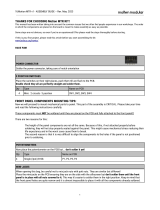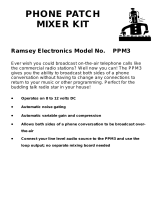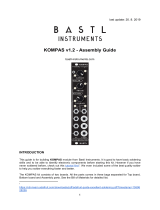Page is loading ...

STEREO MIXER V2 - ASSEMBLY GUIDE – Rev. Mar 2023
THANKS FOR CHOOSING ONE OF OUR KITS!
This assembly guide has been designed taking into account the common issues that we often find people experience in
our workshops. The order in which the components are placed on the board is meant to make assembly as easy as
possible.
Some steps are not obvious, so even if you're an experienced DIYer, please take the time to read the steps thoroughly
before starting.
If this is your first project, please read this article before you start assembling the kit:
www.befaco.org/howto/
GOOD LUCK!
RESISTORS
Color code can be difficult to identify, we strongly recommend to use a multimeter.
Qty
Value
Code
Name on PCB
16
10k
Brown, Black, Black, Red, Brown
R1, R2, R3, R4, R5, R6, R7, R8, R9, R10, R11, R12, R13, R14, R15,
R17
10
100k
Brown, Black, Black, Orange, Brown
R100, R101, R102, R103, R104, R105, R106, R107, R108, R111
4
1k
Brown, Black, Black, Brown, Brown
R109, R110, R112, R113
2
56k
Green, Blue, Black, Red, Brown
R16, R18
DIODES
Solder the diodes observing their polarity. The black or white line on the diode must be in the same place as the white
line on the diode symbol on PCB silkscreen.
Qty
Value
Name on PCB
2
1N5817
D1,D2
FERRITE
To solder the two ferrite beads use a recycled resistor leg passed through each ferrite and proceed as if it were a resistor.
Ferrite beads don't have polarity.
Qty
Name on PCB
2
FERRITE+-, FERRITE-+
1

STEREO MIXER V2 - ASSEMBLY GUIDE – Rev. Mar 2023
CAPACITORS
Mind the polarity of the 10uF capacitors (The long leg of the capacitor is the positive (+)).
Qty
Value
Code
Name on PCB
15
100n
104
C1, C2, C5, C6, C7, C11, C13, C16, C19, C22, C24, C26, C27, C100,
C101
4
10pF
10
C9, C12, C14, C15
12
10uF
10uf (watch the polarity!! )
C3, C4, C8, C10, C17, C18, C20, C21, C23, C25, C28, C29
ICs
First place the sockets (taking care to orientate them properly – the “notch” on one end should match the image of the
silkscreen) and solder them into their correct positions.
Next place the ICs in their respective sockets (again taking note of their polarity - the mark or “notch” on the front of the
IC must match that of the socket and silkscreen).
Note: Make sure to trim down the solder points as much as possible on the opposite side of the PCB to ensure they don’t
touch the base of the Potentiometers.
Qty
Value
Name on PCB
8
TL072
IC1, IC2, IC3, IC4, IC5, IC6, IC7, IC100
PIN HEADERS
Place and solder the Pin Headers on the silkscreen side of the main board (It is the shorter pins that you are soldering).
Double check they all are perfectly straight.
Qty
PINs
Name on PCB
2
2x4
JP1, JP4
1
2x3
JP2
1
2x5
JP3
SOCKET CONNECTORS
Place the socket connectors on the control board over the silkscreen markings at positions and solder. Double check they
all are perfectly straight.
Qty
PINs
Name on PCB
2
2x4
JP101, JP103
1
2x3
JP100
1
2x5
JP102
2

STEREO MIXER V2 - ASSEMBLY GUIDE – Rev. Mar 2023
IDC CONNECTORs
Solder the IDC connectors at bottom face of main board. Orientation is marked by the notch on silskreen, also the small
arrow on the connectors must be on the side with the thick white line or a arrow.
Qty
PINs
Name on PCB
1
2x3
X1
1
2x5
POWER
FRONT PANEL COMPONENTS MOUNTING TIPS:
Now we will proceed to mount the jacks, LEDs and potentiometers. This part of the assembly is CRITICAL. Please take
your time and read the instructions carefully.
These components must NOT be soldered until they are placed on the PCB and fully attached to the front panel.
There are two reasons for this:
The height of the panel components are not all the same. Because of this, if not attached properly before
soldering, they will not stay properly seated against the panel. This might cause mechanical stress reducing their
life expectancy and in the worst case cause them to break.
The second reason is that it is very difficult to align the components to the holes if the panel is not positioned
prior to soldering. In the case of the LEDs, they are almost impossible to set to the correct height without
reference to the front panel.
SPACERs
Secure the spacers onto the CONTROL PCB (through the 3 holes with silver outline) with the main body of the spacer on
the component side, and the nut on the mechanical side.
MINI-JACKS
Place all the mini-jacks onto the PCB ensuring they are on the silkscreen side, but don't solder yet.
POTENTIOMETERS
Place potentiometers, but leave them loose. DO NOT PLACE ALL THE WAY DOWN TO THE PCB. Keep in mind they need
to be screwed tight against the panel.
Do not solder them yet!
Qty
Type
Name on PCB
4
Dual 100k
GAIN_1, GAIN_2, GAIN_3, GAIN_4
3

STEREO MIXER V2 - ASSEMBLY GUIDE – Rev. Mar 2023
LEDs
Place the LED onto the PCB minding their polarity, but don't solder them until the front panel is in place. This is the only
way to solder them in the right position.
The long leg is the positive and the short the negative. On the PCB the square pad indicates the negative side and there
is a + symbol to indicate the positive.
Qty
Name on PCB
2
LED1, LED2
FRONT PANEL
Attach the front panel adjusting the parts one by one if necessary until they fit. At this point a pair of fine tweezers can
be helpful.
To finish:
- Secure the parts to the panel in this order: A) Mini-jacks B) Pots
- Ensuring all of the above parts are flush with the panel then you can finally solder them!
- Next, adjust the LEDS so that they are flush with the panel and solder them.
- Put the knobs on the potentiometers.
- Connect the power ribbon cable: The red wire (-12V) on the power ribbon cable corresponds to pin number one on
the male power connector. The number one pin is indicated with a small triangle on the male power connector and a
white line on the main PCB. A white or black line (or “-12v”) marked on your power bus normally indicates the
corresponding pin.
ENJOY YOUR NEW BEFACO MODULE!
4

STEREO MIXER V2 - ASSEMBLY GUIDE – Rev. Mar 2023
5
/
